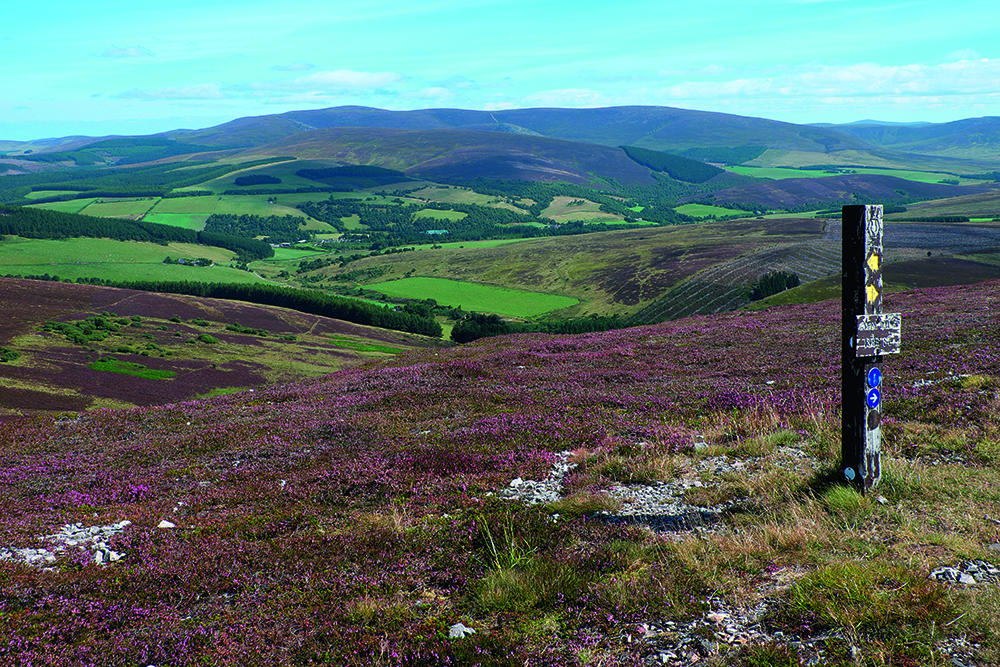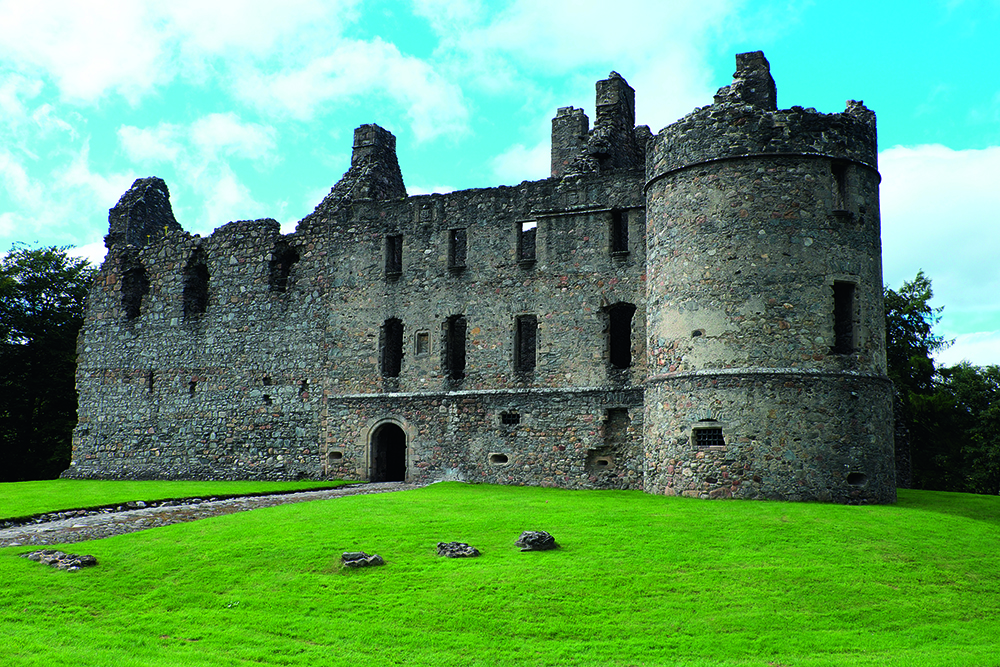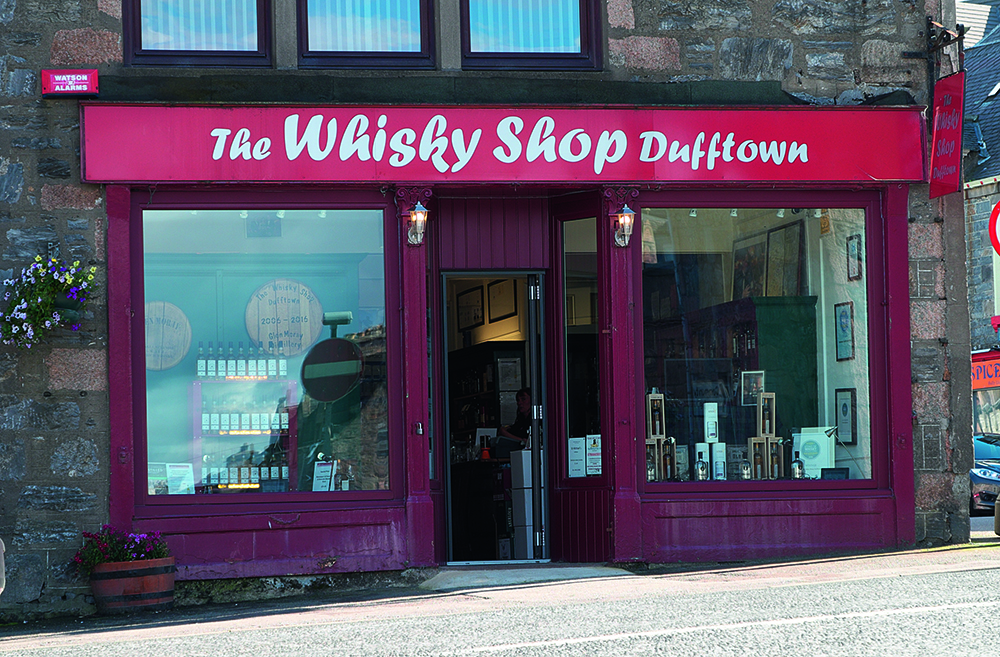Motorhome travel: Walking around Speyside
Cotton-wool clouds were kissing the rounded tops of the Cairngorms’ tundra-like summits far to the south while, closer in, it looked like an artist with an excess of purple paint had been hard at work on the heather moorlands of Glenlivet. We were standing on the 570m (1,870ft) Carn Daimh, admiring the views and trying to match up the toposcope with the various hills on the skyline.

We’d climbed the easy slopes of this heather-clad hill via one of Glenlivet’s excellent waymarked trails. Straddling the northern edge of the Cairngorms National Park in northeast Scotland, this 23,000-hectare estate is part of Crown Estate Scotland, owned by the Queen but managed by the Scottish government. It’s home to 20 waymarked walks, ranging from a half-hour stroll to a 12km (7½ miles) hill walk.
Each trail starts from a dedicated car park, where an information panel provides walk details, including the sort of terrain covered and guidance on where and when you’re most likely to encounter grouse shooters and deer stalkers. I love poring over maps, picturing the landscape and coming up with new walks, but it’s also great occasionally to come across places such as Glenlivet where I can switch off, tuck the map into my daypack and let the waymarkers lead the way.
Armed with detailed walk descriptions that we’d downloaded from the Glenlivet Estate website and encouraged by blue waymarker discs along the way, we did two of the routes during our trip to Speyside and Moray. And, not once did we get lost! The second walk led us into the Braes of Glenlivet, an isolated area dotted with lonely farmsteads and abandoned crofts. This secluded spot, overshadowed by the Ladder Hills, is also home to Scalan, a secret seminary where, in times of Catholic persecution, young men were prepared for the priesthood. Despite repeated attacks on the glen by the Redcoats during the eighteenth century, the so-called ‘heather priests’ who were trained here played a key role in keeping the banned Catholic faith alive in the Highlands.

We came across plenty of other reminders of history’s tumult scattered liberally throughout the Speyside landscape. In truth, I was in danger of becoming castled-out after climbing to the hilltop site of Drumin Castle, exploring the substantial remains of Dufftown’s Balvenie Castle and sitting out a rain shower amid the atmospheric ruins of forlorn Auchindoun Castle, perched on a ridge high above the River Fiddich. Just the thought of one more spiral stairway was starting to make me feel dizzy. But then we stumbled across Huntly Castle...
The skeleton of a once grand, palatial home, built by the Gordons in the sixteenth and early seventeenth centuries, dominates the site. The elaborate frontispiece, with its French influences, is seen as a bold statement of defiance by this Catholic family in post-Reformation times. The chisel marks of Presbyterian covenanters, who occupied the building in 1640 and set about erasing some of the Catholic imagery, can still be seen.
As well as four nights of ‘wild’ camping during our time in northeast Scotland, we also spent a night on a campsite in Aberlour, close to the banks of the River Spey. Just outside the village, Speyside Gardens Caravan Park is a peaceful site inside an old walled garden. Aberlour, or Charlestown of Aberlour to give it its full name, is where the famous Walkers shortbread is made.

It’s also in the heart of whisky country – nearby Dufftown is the self-proclaimed ‘malt whisky capital of the world’. There are dozens of distilleries within a half-hour drive of the village, including producers of some of the world’s most famous single malts such as Glenlivet and Glenfiddich. Many of these organise tours and a few also have cafés. If you’re a real enthusiast, you can even watch skilled coopers at the Speyside Cooperage near Aberlour making the oak casks in which the whisky is stored. The Spirit of Speyside Whisky Festival is held in early May, giving visitors the chance to attend whisky auctions, go on exclusive distillery tours and have tutored tastings.
Wildlife sightings included a couple of brown hares, a peregrine falcon and one red deer. The region is also home to red squirrels, ptarmigans, black grouse, mountain hares, golden eagles and otters as well as some rarer, more elusive characters such as wild cats and pine martens. Following the River Spey downstream, we headed north to the coast in the hope of spotting dolphins. The Moray Firth is home to one of the two largest populations of bottlenose dolphins in British waters; the other is in Wales.
At Spey Bay, where the river enters the sea, we found the Scottish Dolphin Centre, run by the Whale and Dolphin Conservation charity. The free visitor centre was full of families enjoying the informative displays. The centre offers a number of walks and tours, including an hourly land-based dolphin watch, twilight wildlife-watching walks and tours of the UK’s largest icehouse. Built in 1830, the latter formed part of the Tugnet fishing station. Ice blocks would be cut from the River Spey during the winter and placed in the ice house, most of which is underground. Salmon and other fish caught could then be kept fresh until it was ready to be shipped.
.jpg)
Further east along the coast, we called in at Cullen, the birthplace of Cullen skink, a hearty soup of smoked haddock, potatoes, milk and onions. Every November in the royal burgh, competitors take part in the Cullen Skink World Championships, battling it out to have their soup named as the best on the planet.
As sea-kayakers brought their boats in for the night, we took an evening stroll around Seatown, the lower part of the settlement. Here, tiny fishermen’s cottages divided by narrow alleyways turn their gable ends to the sea, huddling together for shelter from winter storms. It’s a pretty spot, towered over by an imposing eight-arch viaduct that once carried trains on the Elgin-to-Aberdeen line; today it carries cyclists and walkers.
Further east still, and just over the border in Aberdeenshire, we stumbled across the sort of place that, if it were further south, would be overrun with tourists. As it is, though, Findlater seemed to be the haunt solely of local dog walkers and young couples out for a romantic – and slightly adventurous – stroll. Having seen a coastal castle marked on the Ordnance Survey map, we left the campervan in the large parking area beside the Barnyards of Findlater and walked down to the cliffs.
En route, we paid a visit to the sixteenth-century Findlater Doocot (or dovecote). Stepping inside the beehive-style building, restored in 1992, the pile of feathers and guano on the floor suggested that birds still visit. Findlater Castle itself sits on a promontory connected to the cliffs by only a narrow strip of land. With strong gusts blowing from time to time and the grass greasy from the last shower, I didn’t fancy the crossing.
From the castle, clifftop paths head east towards Sandend and west towards Cullen. We couldn’t decide which way to go, so did a little of both. On our westward journey, we dropped to the hidden beach at Sunnyside. Another case of the dry Scottish sense of humour, perhaps in naming a north-facing beach Sunnyside? But there was no denying the beauty of this sandy bay, sheltered from the prevailing winds by cliffs and rocky headlands.
A walker, accompanied by a lively 14-month-old golden retriever called Bonny, was as enthused by the location as we were – despite being a regular visitor. “My friends think this is too far to walk with their dogs, but they don’t know what they’re missing. Just look at it!” Realising we were holidaymakers, she then reeled off a list of other walks we could do in the area. The Bin of Cullen, the Giant’s Steps, Crannoch Wood... We explained we were heading back home the following day. “You’ll have to come back then, won’t you?” she said. I told her we probably would and immediately started planning another trip in my head. We could head north from Aberdeen and work our way round to Inverness. Or we could start further south, in Stonehaven, perhaps, or Montrose, or even Dundee...






.jpg)


Recent Updates
Campsites in the Lake District: our pick of the best
This National Park is one of the most iconic locations in the UK for outdoor adventures, which makes camping in the Lake District an absolute must - ...
Campsites in Kent: our pick of the best
This is our guide to the best attractions and top campsites in the Garden of England, from the iconic cliffs ...
Camping guide to trailers
Trailer stash or trailer trash? Being able to carry lots of other gear when you go camping isn’t such a bad ...
Campsites in Cornwall: our pick of the best
Our selection of the best campsites for exploring one of England's most popular counties ...
Campsites in Devon: our pick of the best
The best campsites for discovering this popular southwest county ...
Coastal campsites: our pick of the best in Britain
Enjoy being beside the seaside with our choice of the best coastal campsites in England, Scotland and Wales ...
Best family campsites in the UK
Our pick of the best campsites for a family holiday ...
Campsites in Wales: our pick of the best
Our selection of the best campsites for exploring wonderful Wales ...
Top campsites near cities for weekend breaks
For a multitude of things to see and do all year round, head for the city with our top campsites for city ...
Campsites open all year: our pick of the best
Enjoy holidays year-round with this selection of campsites that are open all year ...
Other Articles
Campsites in Scotland: our pick of the best
Our choice of the top campsites to enjoy a touring adventure in Scotland, from the Highlands to the wild Scottish coast ...
Yorkshire campsites: our pick of the best
Perfect for exploring Yorkshire, check out these high-quality campsites ...
Campsites in Dorset: our pick of the best
From the stunning coastlines to beautiful countryside, Dorset is perfect for a camping holiday ...
Dog-friendly campsites: our pick of the best
The best campsites for a holiday with your four-legged friend ...
Theme park campsites: our pick of the best
If your idea of a top family holiday is strapping yourself in for thrills and spills on some of the best UK ...
Adults-only campsites: our pick of the best
For a grown-ups-only holiday, check out our recommended sites just for adults ...
Location guide: heavenly Hampshire
Hampshire – a glimpse of a wonderful combination of coast, countryside and city. This attraction-rich region ...
Fishery Creek Touring Park: campsite review
A campsite review of Fishery Creek Touring Park, Hampshire ...
Camping with dogs
Camping is for the whole family – including the four-legged members. Follow our tips for trouble-free camping ...
Location guide: Cornwall attractions
What to see and do in Cornwall ...